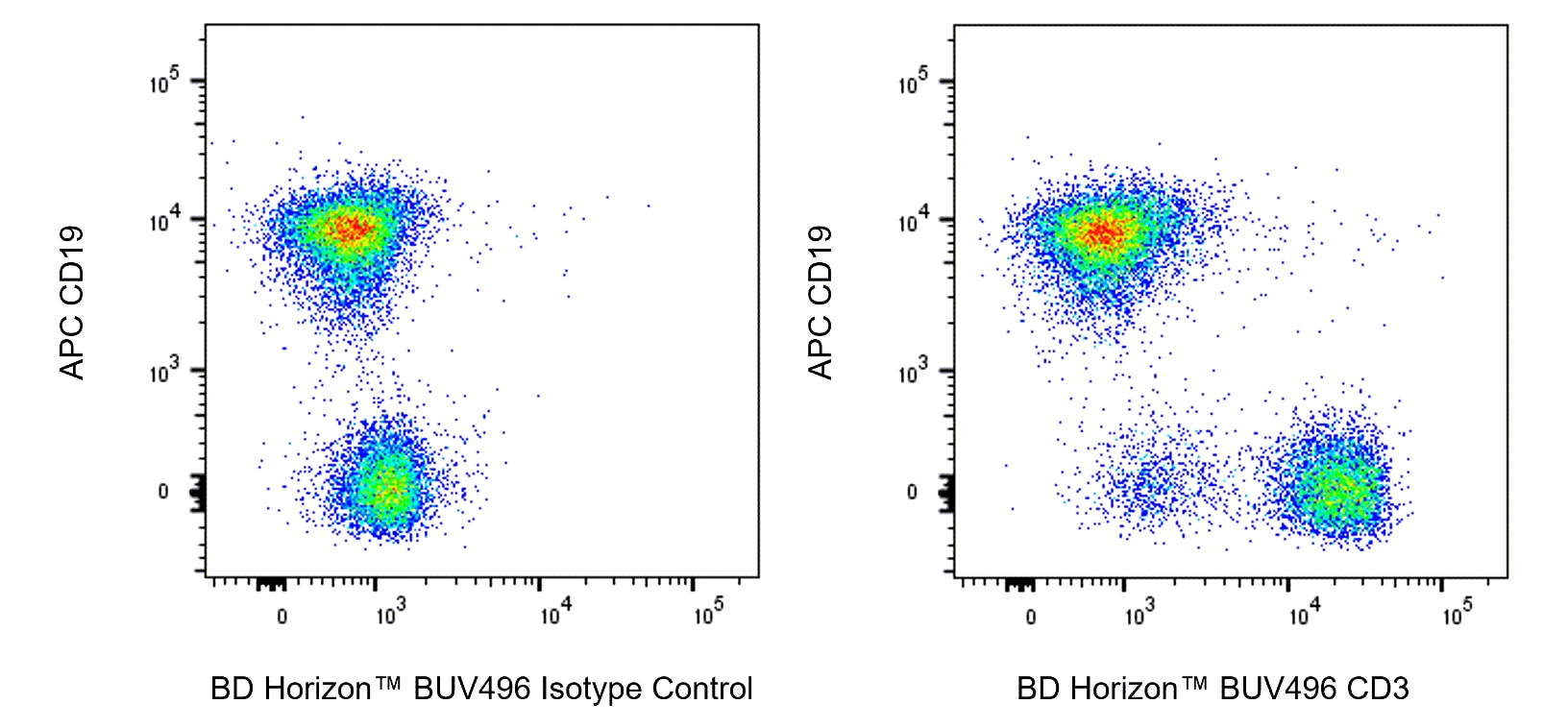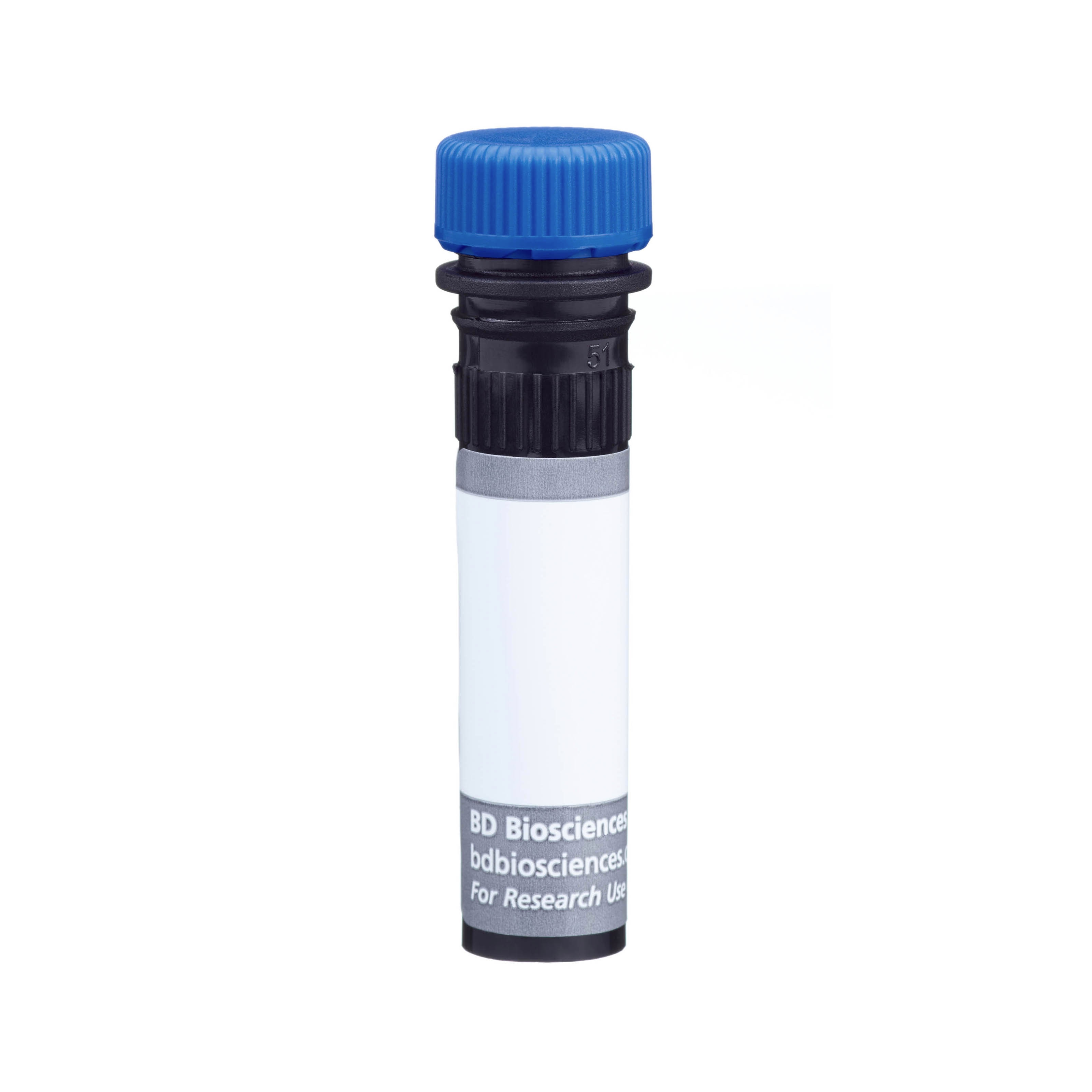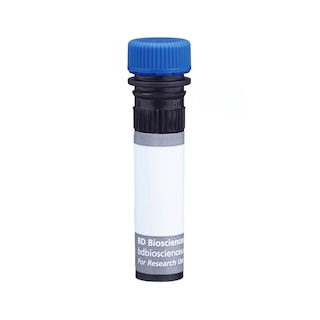Old Browser
This page has been recently translated and is available in French now.
Looks like you're visiting us from {countryName}.
Would you like to stay on the current country site or be switched to your country?




Multicolor flow cytometric analysis of CD3 expression on viable Mouse splenic leukocytes. C57BL/6 Mouse splenocytes were treated with BD Pharm Lyse™ Lysing Buffer (Cat. No. 555899) to lyse erythrocytes, washed, and preincubated with Purified Rat Anti-Mouse CD16/CD32 antibody (Mouse BD Fc Block™) [Cat. No. 553142]. The cells were then stained with APC Rat Anti-Mouse CD19 antibody (Cat. No. 550992/561738) and with either BD Horizon™ BUV496 Rat IgG2b, κ Isotype Control (Cat. No. 612954; Left Plot) or BD Horizon™ BUV496 Rat Anti-Mouse CD3 antibody (Cat. No. 569671; Right Plot) at 1 µg/test. DAPI (4',6-Diamidino-2-Phenylindole, Dihydrochloride) Solution (Cat. No. 564907) was added to cells right before analysis. The bivariate pseudocolor density plot showing the correlated expression of CD3 (or Ig Isotype control staining) versus CD19 was derived from gated events with the forward and side light-scatter characteristics of viable (DAPI-negative) splenic leukocytes. Flow cytometry and data analysis were performed using a BD LSRFortessa™ X-20 Cell Analyzer System and FlowJo™ software. Data shown on this Technical Data Sheet are not lot specific.


BD Horizon™ BUV496 Rat Anti-Mouse CD3

Regulatory Status Legend
Any use of products other than the permitted use without the express written authorization of Becton, Dickinson and Company is strictly prohibited.
Preparation And Storage
Recommended Assay Procedures
BD® CompBeads can be used as surrogates to assess fluorescence spillover (compensation). When fluorochrome conjugated antibodies are bound to BD® CompBeads, they have spectral properties very similar to cells. However, for some fluorochromes there can be small differences in spectral emissions compared to cells, resulting in spillover values that differ when compared to biological controls. It is strongly recommended that when using a reagent for the first time, users compare the spillover on cells and BD® CompBeads to ensure that BD® CompBeads are appropriate for your specific cellular application.
For optimal and reproducible results, BD Horizon Brilliant Stain Buffer should be used anytime BD Horizon Brilliant dyes are used in a multicolor flow cytometry panel. Fluorescent dye interactions may cause staining artifacts which may affect data interpretation. The BD Horizon Brilliant Stain Buffer was designed to minimize these interactions. When BD Horizon Brilliant Stain Buffer is used in in the multicolor panel, it should also be used in the corresponding compensation controls for all dyes to achieve the most accurate compensation. For the most accurate compensation, compensation controls created with either cells or beads should be exposed to BD Horizon Brilliant Stain Buffer for the same length of time as the corresponding multicolor panel. More information can be found in the Technical Data Sheet of the BD Horizon Brilliant Stain Buffer (Cat. No. 563794/566349) or the BD Horizon Brilliant Stain Buffer Plus (Cat. No. 566385).
Note: When using high concentrations of antibody, background binding of this dye to erythroid cell subsets (mature erythrocytes and precursors) has been observed. For researchers studying these cell populations, or in cases where light scatter gating does not adequately exclude these cells from the analysis, this background may be an important factor to consider when selecting reagents for panel(s).
Product Notices
- Please refer to www.bdbiosciences.com/us/s/resources for technical protocols.
- Since applications vary, each investigator should titrate the reagent to obtain optimal results.
- An isotype control should be used at the same concentration as the antibody of interest.
- Caution: Sodium azide yields highly toxic hydrazoic acid under acidic conditions. Dilute azide compounds in running water before discarding to avoid accumulation of potentially explosive deposits in plumbing.
- For fluorochrome spectra and suitable instrument settings, please refer to our Multicolor Flow Cytometry web page at www.bdbiosciences.com/colors.
- BD Horizon Brilliant Ultraviolet 496 is covered by one or more of the following US patents: 8,110,673; 8,158,444; 8,227,187; 8,575,303; 8,354,239.
- BD Horizon Brilliant Stain Buffer is covered by one or more of the following US patents: 8,110,673; 8,158,444; 8,575,303; 8,354,239.
- Please refer to http://regdocs.bd.com to access safety data sheets (SDS).
- For U.S. patents that may apply, see bd.com/patents.
Companion Products






The 17A2 monoclonal antibody specifically binds to the T-cell receptor-associated CD3 complex that is expressed on many thymocytes and mature T lymphocytes. Plate-bound 17A2 antibody has been reported to induce IL-2 production by cultured T cells in the absence of accessory cells. The binding of the 17A2 antibody to T cells can be blocked by the anti-CD3e mAb 145-2C11 (Cat. No. 557306/553058/550275). This suggests that the 17A2 antibody recognizes an epitope of the CD3 epsilon chain. In vivo treatment with 17A2 antibody has been reported to partially deplete T lymphocytes and temporarily down-modulates CD3 expression on T cells.

Development References (4)
-
Breitbach M, Kimura K, Luis TC, et al. In Vivo Labeling by CD73 Marks Multipotent Stromal Cells and Highlights Endothelial Heterogeneity in the Bone Marrow Niche.. Cell Stem Cell. 2018; 22(2):262-276.e7. (Clone-specific: Flow cytometry, Fluorescence activated cell sorting). View Reference
-
Miescher GC, Schreyer M, MacDonald HR. Production and characterization of a rat monoclonal antibody against the murine CD3 molecular complex. Immunol Lett. 1989; 23(2):113-118. (Immunogen: Cytotoxicity, Flow cytometry, Functional assay, Immunohistochemistry, Immunoprecipitation, Stimulation). View Reference
-
Mysliwietz J, Thierfelder S. Antilymphocytic antibodies and marrow transplantation. XII. Suppression of graft-versus-host disease by T-cell-modulating and depleting antimouse CD3 antibody is most effective when preinjected in the marrow recipient. Blood. 1992; 80(10):2661-2667. (Clone-specific: Depletion, Flow cytometry, Functional assay, In vivo exacerbation). View Reference
-
Wu L, Antica M, Johnson GR, Scollay R, Shortman K. Developmental potential of the earliest precursor cells from the adult mouse thymus. J Exp Med. 1991; 174(6):1617-1627. (Clone-specific: Cell separation, Depletion). View Reference
Please refer to Support Documents for Quality Certificates
Global - Refer to manufacturer's instructions for use and related User Manuals and Technical data sheets before using this products as described
Comparisons, where applicable, are made against older BD Technology, manual methods or are general performance claims. Comparisons are not made against non-BD technologies, unless otherwise noted.
For Research Use Only. Not for use in diagnostic or therapeutic procedures.
Report a Site Issue
This form is intended to help us improve our website experience. For other support, please visit our Contact Us page.